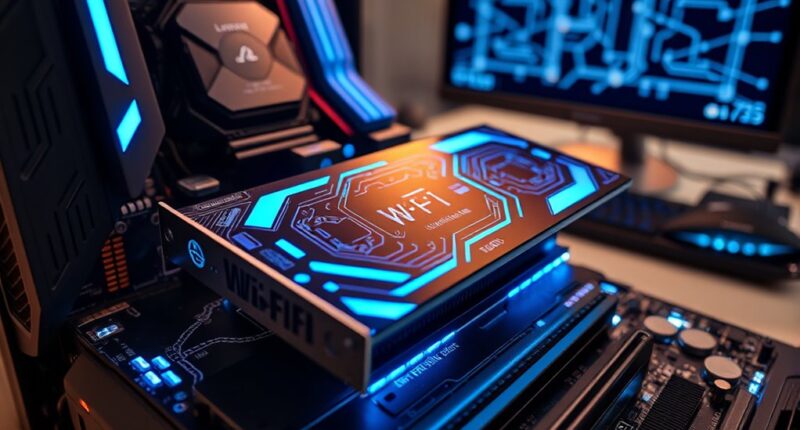If you’re looking for the best Wi-Fi 7 PCIe cards for faster, reliable connectivity in 2025, I recommend checking out options like the TP-Link WiFi 7 PCIe, MSI Herald-BE MAX, and Cudy WiFi 7 cards. These models support blazing speeds up to 9.3 Gbps, feature advanced technologies like OFDMA and Multi-Link Operation, and come with external antennas for better coverage. Keep in mind compatibility and setup details—there’s more to uncover for peak performance.
Key Takeaways
- Look for Wi-Fi 7 PCIe cards supporting speeds up to 9.3 Gbps and multi-band (2.4GHz, 5GHz, 6GHz) for maximum performance.
- Prioritize models with advanced features like OFDMA, MU-MIMO, MLO, and beamforming to ensure reliable, low-latency connections.
- Check compatibility with your system’s PCIe slots, Windows version, and antenna support for seamless installation.
- Consider cards with external antennas or high-gain options to improve signal stability and coverage in challenging environments.
- Review driver support and manufacturer updates to ensure future-proof, stable connectivity in 2025 and beyond.
TP-Link WiFi 7 PCIe WiFi Card for Desktop PCs
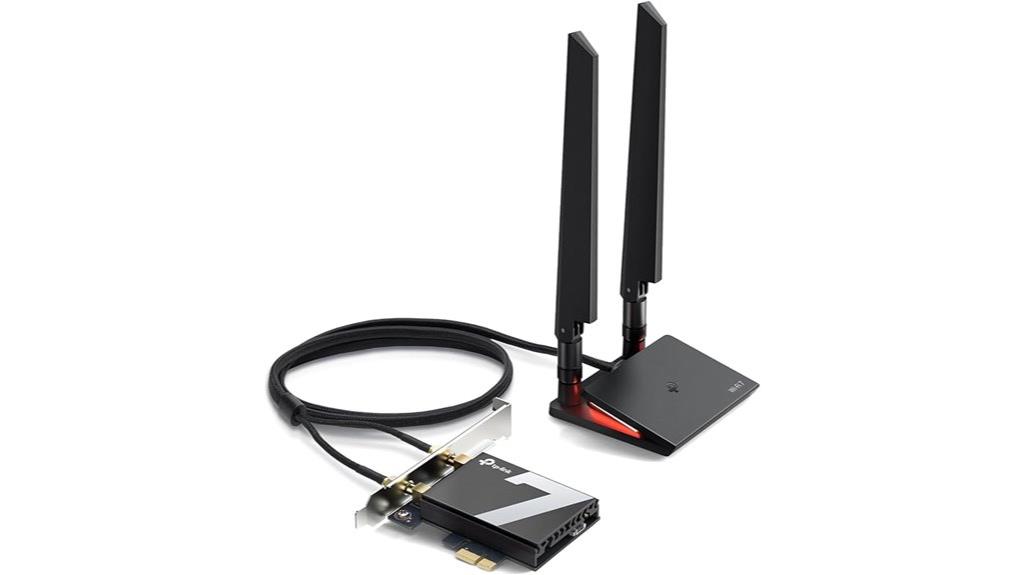
If you’re looking for a top-tier Wi-Fi 7 PCIe card for your desktop, the TP-Link WiFi 7 PCIe WiFi Card stands out with its advanced technology and high speeds. It leverages Wi-Fi 7 to access the full potential of the 6 GHz band, offering congestion-free channels and exceptional bandwidth. With 4096-QAM and 320MHz, it delivers blazing speeds—up to 5760 Mbps on 6 GHz, 2880 Mbps on 5 GHz, and 688 Mbps on 2.4 GHz. Its multi-antenna design ensures strong, adjustable signals, while features like OFDMA and MU-MIMO minimize lag. Compatible with Windows 11 and AMD/Intel motherboards, it’s perfect for gaming, streaming, and high-performance tasks.
Best For: gamers, streamers, and high-performance desktop users seeking ultra-fast, low-lag Wi-Fi connectivity with advanced Wi-Fi 7 technology.
Pros:
- Delivers blazing fast speeds up to 5760 Mbps on 6 GHz, ideal for gaming and streaming.
- Supports advanced features like OFDMA, MU-MIMO, and Multi-RU for minimal lag and smooth performance.
- Compatible with Windows 11 and adjustable antennas for optimized signal coverage.
Cons:
- Not compatible with Windows 10, limiting use for users with older OS.
- Requires PCIe slot; not suitable for laptops or compact systems.
- May need technical installation knowledge due to hardware setup and antenna adjustments.
MSI Herald-BE Wi-Fi 7 MAX Network Adapter
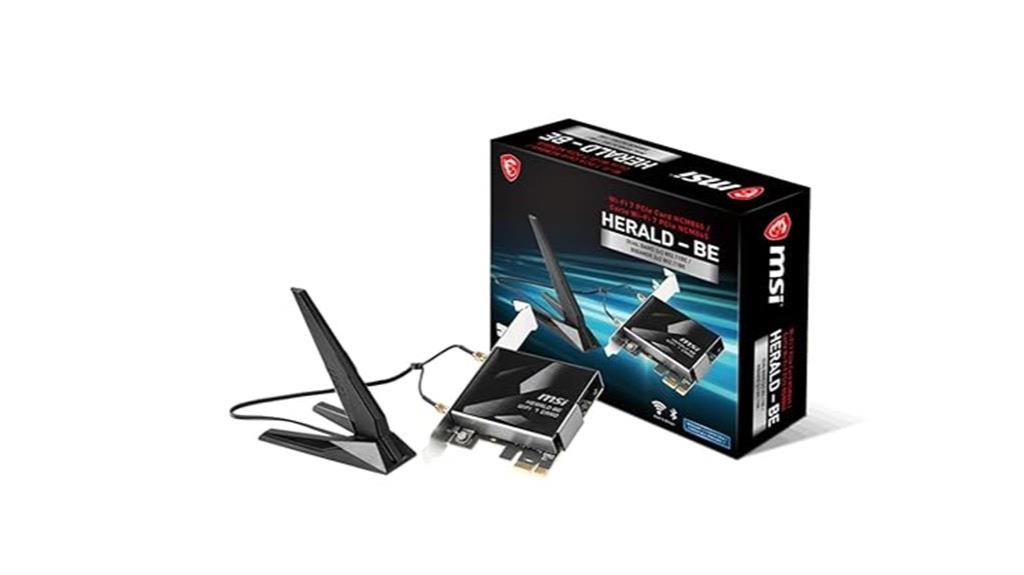
Looking for a high-performance Wi-Fi 7 PCIe card that caters to gamers and power users? The MSI Herald-BE Wi-Fi 7 MAX Network Adapter delivers blazing speeds up to 5.8 Gbps, thanks to its Wi-Fi 7 (802.11BE) chipset and 320 MHz channels on 6GHz. It features Bluetooth 5.4, Multi-Link Operation, and an external magnetic antenna for better reception. Installation is straightforward, though some compatibility tweaks may be needed, especially with Bluetooth. Users praise its speed, stability, and sleek design, making it ideal for demanding gaming setups and fast data transfers. Just guarantee your motherboard supports the necessary connections for ideal Bluetooth performance.
Best For: gamers and power users seeking ultra-fast, reliable Wi-Fi 7 connectivity with easy installation and enhanced reception.
Pros:
- Supports blazing transfer speeds up to 5.8 Gbps, ideal for high-bandwidth activities
- Features Bluetooth 5.4 and Multi-Link Operation for versatile connectivity
- External magnetic antenna improves signal reception and overall stability
Cons:
- May require manual wiring adjustments for Bluetooth functionality on certain motherboards
- Compatibility issues with older operating systems like Windows 10 and Linux
- Driver installation can sometimes be problematic, especially if drivers are outdated or not downloaded from MSI’s official site
WiFi 7 PCIe Card with Bluetooth 5.4 for Windows 11
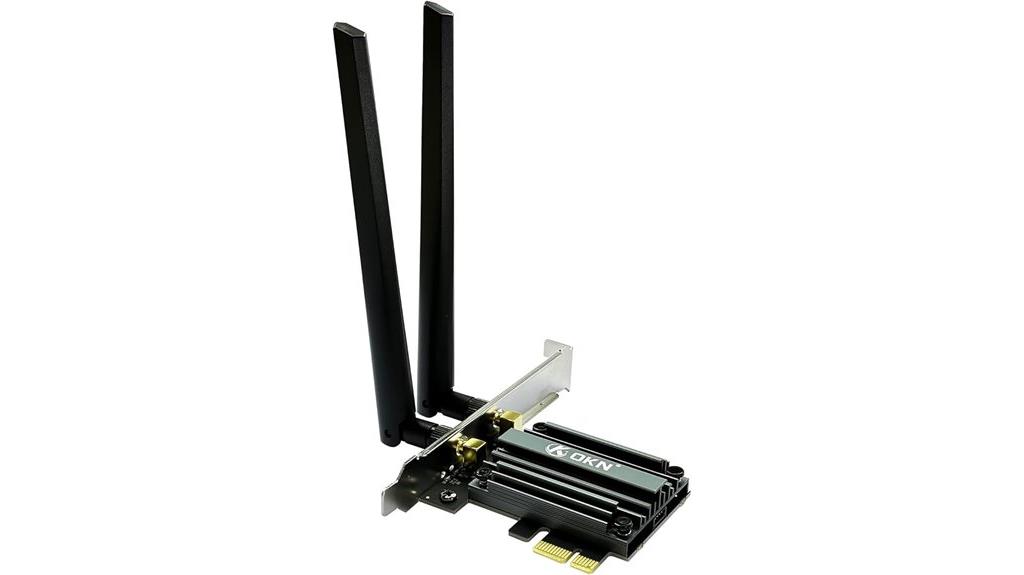
For users seeking ultra-fast wireless connectivity combined with seamless Bluetooth integration, the WiFi 7 PCIe Card with Bluetooth 5.4 for Windows 11 stands out as an excellent choice. It supports the latest 6GHz band, delivering peak data speeds up to 9.3Gbps with the Intel BE200 chipset. Its Bluetooth 5.4 guarantees low latency and high data transfer rates for peripherals. Compatible with Windows 10 and 11, it requires a PCIe x1, x4, x8, or x16 slot. This card is ideal for demanding applications like 4K streaming, gaming, and AR/VR, offering reliable performance and enhanced capacity. Its compact design fits easily into most systems, making it a versatile upgrade.
Best For: users seeking ultra-fast wireless connectivity and seamless Bluetooth integration for gaming, streaming, and AR/VR applications on Windows 11.
Pros:
- Supports peak data speeds up to 9.3Gbps with WiFi 7 (802.11be) and 6GHz band.
- Incorporates Bluetooth 5.4 for low latency and high data transfer rates.
- Compatible with multiple PCIe slots (x1, x4, x8, x16) and Windows 10/11 64-bit systems.
Cons:
- Not compatible with AMD motherboards.
- Requires installation of drivers from Intel’s website, which may be complex for some users.
- Slightly larger dimensions may require check for fit in compact cases.
Cudy WiFi 7 PCIe WiFi Card for PC
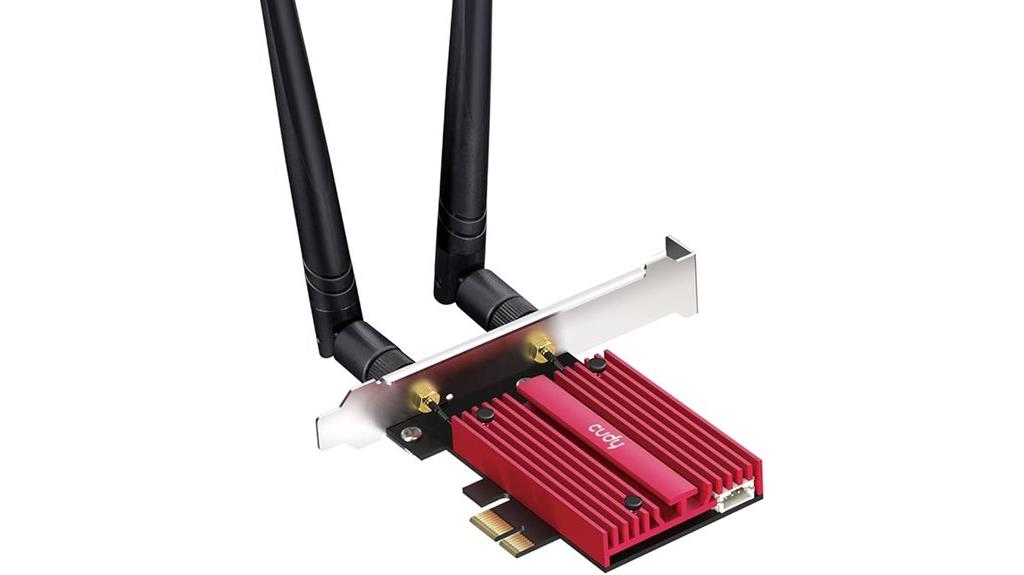
The Cudy WiFi 7 PCIe WiFi Card stands out for users seeking ultra-fast, reliable internet on their Windows 11 PCs, especially those with Intel platforms. It supports Wi-Fi 7 technology, offering access to the 6 GHz tri-band spectrum for speeds up to 5760 Mbps. With the built-in Intel BE200 chipset, it ensures stable, high-performance connectivity. The card features two high-performance antennas that improve reception, coverage, and stability. Easy to install, it’s compatible only with Intel-based Windows 11 systems, making it ideal for those wanting cutting-edge wireless performance. Rated 4.6 stars, it’s a top choice for upgrading your PC’s wireless capabilities in 2025.
Best For: users with Intel-based Windows 11 PCs seeking ultra-fast, reliable Wi-Fi 7 connectivity and easy installation.
Pros:
- Supports Wi-Fi 7 tri-band spectrum with speeds up to 5760 Mbps on 6 GHz
- Built-in Intel BE200 chipset for stable, high-performance internet connections
- Includes two multi-directional antennas for improved reception, coverage, and stability
Cons:
- Compatible only with Intel-Windows 11 platforms, not supporting AMD systems
- Limited to Windows 11, so not suitable for other operating systems
- First available in July 2024, which may lead to limited initial stock or higher prices
TP-Link WiFi 7 PCIe WiFi Card (BE9300)
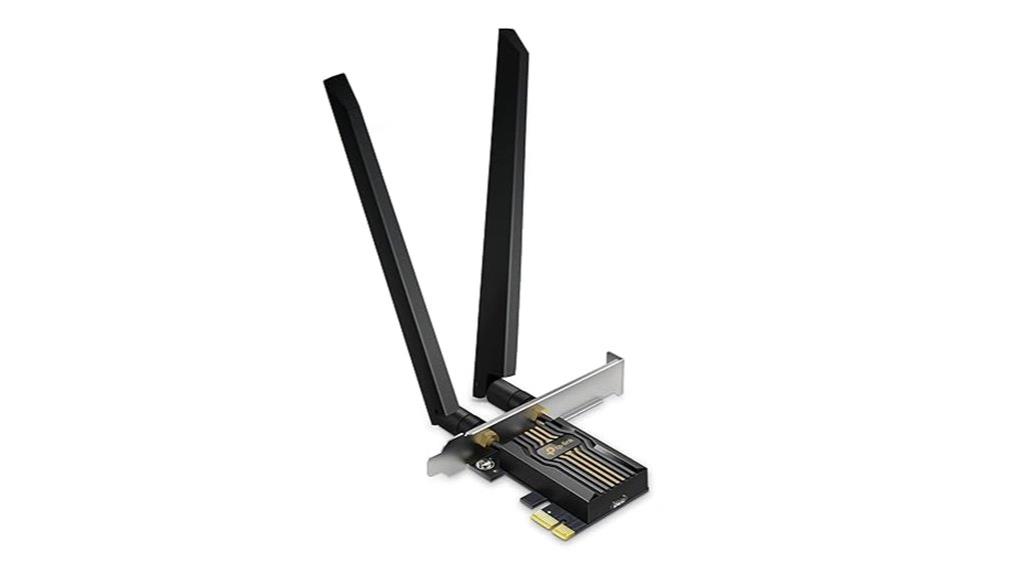
If you’re seeking lightning-fast, stable Wi-Fi for your desktop, the TP-Link WiFi 7 PCIe Card (BE9300) is an excellent choice. It leverages Wi-Fi 7 technology, offering up to 5764 Mbps on the 6 GHz band, with support for 320 MHz channels on compatible routers. Its tri-band setup ensures optimized connectivity across 6, 5, and 2.4 GHz bands. The card features advanced tech like Multi-Link Operation, Multi-RUs, and 4K-QAM, enhancing speed and efficiency. With high-gain antennas, it extends signal coverage, and WPA3 security keeps your network safe. Compatibility with AMD and Intel motherboards makes it perfect for high-performance desktops.
Best For: gamers, streamers, and high-performance desktop users seeking ultra-fast, stable Wi-Fi 7 connectivity.
Pros:
- Delivers speeds up to 5764 Mbps, ideal for high-demand applications and gaming.
- Supports advanced Wi-Fi 7 features like Multi-Link Operation and 4K-QAM for improved performance.
- Equipped with high-gain antennas for extended coverage and stable connection.
Cons:
- Not compatible with Windows 10, limiting user options.
- Requires a compatible Wi-Fi 7 router to unlock full bandwidth potential.
- May be more expensive than standard Wi-Fi cards due to advanced features.
TP-Link WiFi 7 PCIe WiFi Card (BE6500)

Designed for enthusiasts who demand ultra-fast, reliable wireless connections, the TP-Link WiFi 7 PCIe WiFi Card (BE6500) stands out with its tri-band support and Wi-Fi 7 technology. It delivers impressive speeds up to 6.5 Gbps across three bands—2882 Mbps on 6 GHz and 5 GHz, plus 688 Mbps on 2.4 GHz—ensuring smooth gaming, streaming, and large data transfers. Equipped with Multi-Link Operation, OFDMA, MU-MIMO, and beamforming antennas, it boosts coverage and stability. Compatibility with AMD and Intel motherboards, along with WPA3 security, makes it a future-proof upgrade for desktops seeking top-tier performance in 2025.
Best For: enthusiasts and power users seeking ultra-fast, reliable Wi-Fi 7 and Bluetooth 5.4 connectivity for gaming, streaming, and large data transfers on desktop PCs.
Pros:
- Supports Wi-Fi 7 with speeds up to 6.5 Gbps for future-proof high-performance connectivity
- Equipped with advanced features like Multi-Link Operation, OFDMA, MU-MIMO, and beamforming for enhanced coverage and stability
- Includes Bluetooth 5.4 with reliable, secure connections and low energy consumption
Cons:
- Requires an internal USB header for full Bluetooth functionality, which may not be available on all motherboards
- Installation and optimal performance depend on selecting the correct PCIe slot and proper configuration
- Slightly larger physical size may require a low-profile bracket for compact cases
GIGABYTE WiFi 7 PCIe Expansion Card
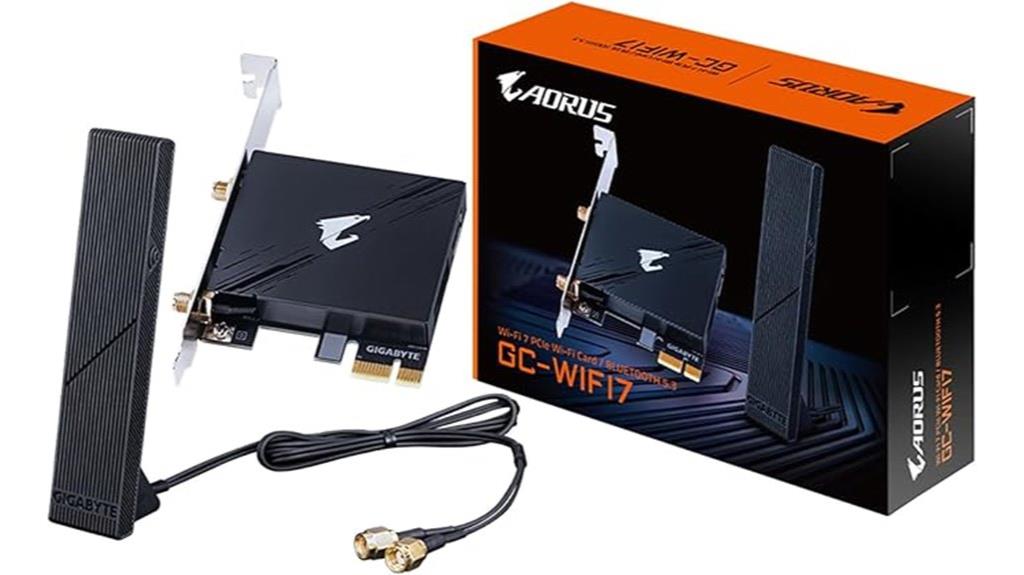
Gamers, content creators, and professionals demanding fast, stable wireless connections will find the GIGABYTE WiFi 7 GC-WIFI7 PCIe expansion card to be an excellent choice. It supports Wi-Fi 7 (802.11ax), Bluetooth 5.3, and tri-band operation across 2.4GHz, 5GHz, and 6GHz, delivering speeds up to 5800Mbps. Its advanced tech—4K-QAM, MLO, and MRU—ensures higher transmission rates, multi-band reliability, and improved interference mitigation. Designed for high-performance networking, this card offers seamless multi-band connectivity, reducing latency and boosting efficiency. Whether for gaming, streaming, or professional work, it’s a robust solution for demanding applications requiring fast, consistent wireless performance.
Best For: gamers, content creators, and professionals seeking high-speed, reliable wireless connectivity for demanding applications.
Pros:
- Supports Wi-Fi 7 (802.11ax) with speeds up to 5800Mbps for fast, stable connections
- Tri-band operation across 2.4GHz, 5GHz, and 6GHz for comprehensive coverage and reduced interference
- Incorporates advanced technologies like 4K-QAM, MLO, and MRU for improved transmission rates and network efficiency
Cons:
- May require a PCIe slot and compatible system for installation, limiting use in some setups
- Potentially higher cost compared to older Wi-Fi expansion options
- Advanced features might be unnecessary for casual users with basic internet needs
WiFi 7 PCIe Card for Desktop PC
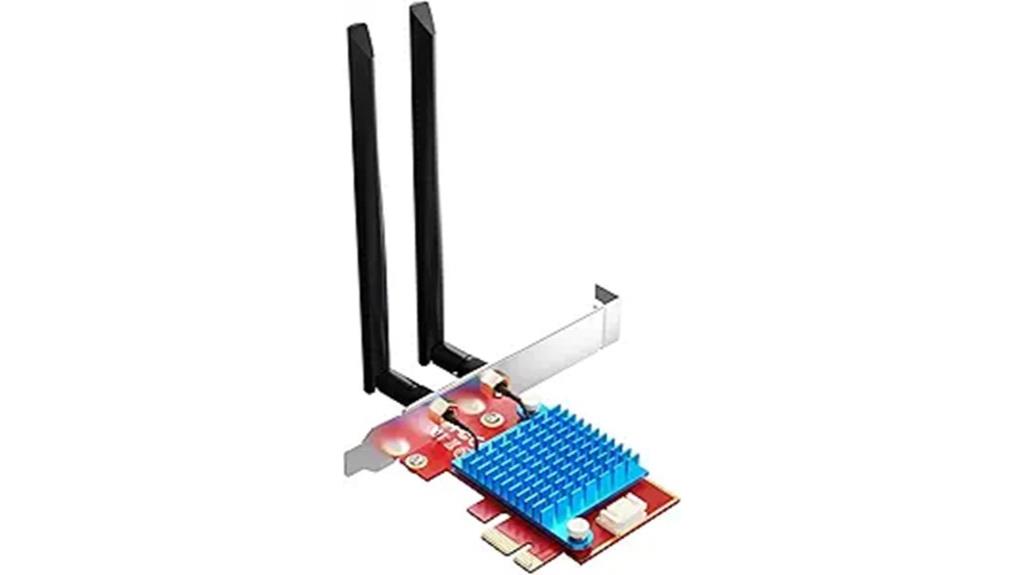
The WiFi 7 PCIe card featuring the Intel BE200 chipset stands out as an excellent choice for desktop users seeking lightning-fast wireless connectivity, especially those who demand high bandwidth for gaming, streaming, or large data transfers. It supports WiFi 7’s advanced features, delivering speeds up to 9.3Gbps with tri-band 6GHz support, WPA3 security, and OFDMA for efficiency. Compatibility is limited to Windows 10 and 11 64-bit systems, with easy setup via Intel’s drivers. Compact and lightweight at just over 5 ounces, this card also includes Bluetooth 5.4 for seamless peripheral connections, making it a top-tier upgrade for high-performance desktops.
Best For: high-performance desktop users who need ultra-fast WiFi, seamless peripheral connectivity, and support for demanding gaming or streaming applications on Windows 10/11 systems.
Pros:
- Delivers ultra-fast speeds up to 9.3Gbps with WiFi 7 tri-band support
- Includes Bluetooth 5.4 for low-latency wireless peripheral connections
- Compact, lightweight design for easy installation and minimal desk clutter
Cons:
- Compatible only with Windows 10/11 64-bit; not suitable for AMD processors
- Limited customer ratings with room for improved user satisfaction
- Requires driver download from Intel website, which may be a minor setup step for some users
ASUS PCE-BE92BT WiFi 7 PCI-E Adapter

If you’re seeking ultrafast WiFi 7 connectivity with reliable coverage, the ASUS PCE-BE92BT PCIe adapter is an excellent choice, especially for users with Intel motherboards. It supports WiFi 7’s cutting-edge technology, delivering speeds up to 2.4 times faster than older standards. The adapter uses the new 6 GHz band with 320 MHz bandwidth, reducing congestion and interference. It also features two external antennas for better signal strength and coverage, plus Bluetooth 5.4 for versatile device connections. With WPA3 security, OFDMA, and MU-MIMO, it ensures secure, efficient, and low-latency network performance for demanding applications.
Best For: users with Intel motherboards seeking ultrafast WiFi 7 connectivity, enhanced security, and reliable coverage for demanding applications.
Pros:
- Supports WiFi 7 technology with speeds up to 2.4 times faster than previous standards
- Features dual external antennas for improved signal strength and coverage
- Includes Bluetooth 5.4 for versatile device connectivity and enhanced energy efficiency
Cons:
- Compatibility is limited to Intel motherboards, restricting use with other platforms
- Requires a PCIe slot, which may not be available in all systems
- The advanced features and high-speed capabilities may come at a higher price point
Intel Killer BE200 Wi-Fi 7 & Bluetooth 5.4 Card with M.2 PCIe Interface
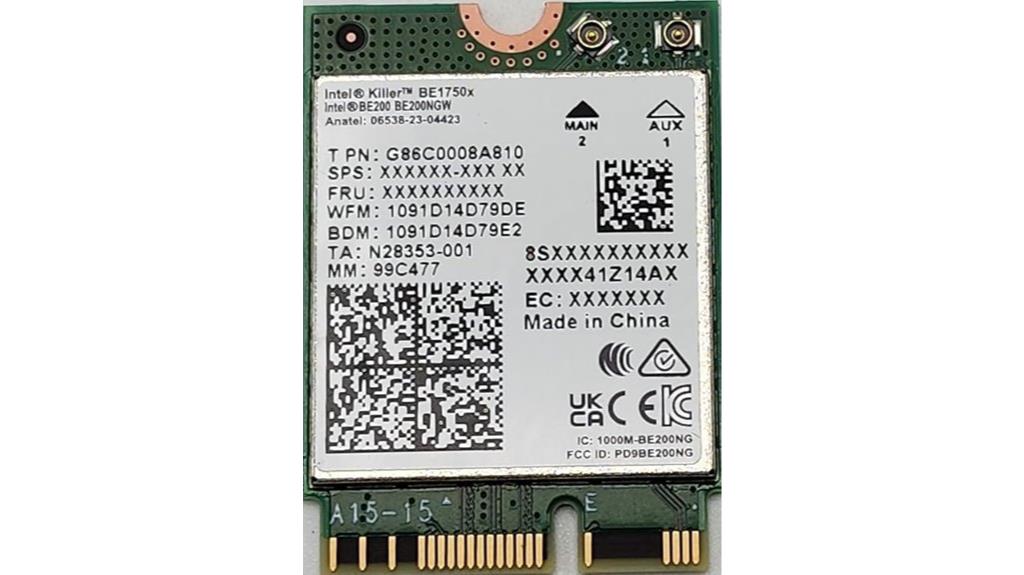
For anyone aiming to upgrade their PC with ultra-fast Wi-Fi 7 connectivity, the Intel Killer BE200 Wi-Fi 7 & Bluetooth 5.4 Card stands out as a top choice. This M.2 PCIe Key E card supports tri-band Wi-Fi 7 with speeds up to 5.8 Gbps, perfect for gaming, streaming, and low-latency tasks. It’s designed for Intel processors and requires Windows 11, with a compatible M.2 slot. The inclusion of Bluetooth 5.4 allows for modern wireless peripherals. Its sleek white/green design makes installation straightforward, offering high performance and reliable connectivity. If you have an Intel system and need cutting-edge wireless tech, this card is an excellent upgrade option.
Best For: gamers, streamers, and high-performance PC users seeking ultra-fast, low-latency Wi-Fi 7 connectivity with Bluetooth 5.4 support on an Intel-based system.
Pros:
- Supports Wi-Fi 7 tri-band speeds up to 5.8 Gbps for high-speed wireless performance
- Includes Bluetooth 5.4 for compatibility with modern wireless peripherals
- Easy to install with M.2 PCIe Key E interface, suitable for Intel systems
Cons:
- Not compatible with AMD-based systems
- Requires Windows 11 (64-bit), limiting compatibility with older OS versions
- Performance depends on network hardware and environment, which may affect maximum speeds
FENVi PCIe WiFi 7 Network Card (BE8800pro) for Windows 11/10
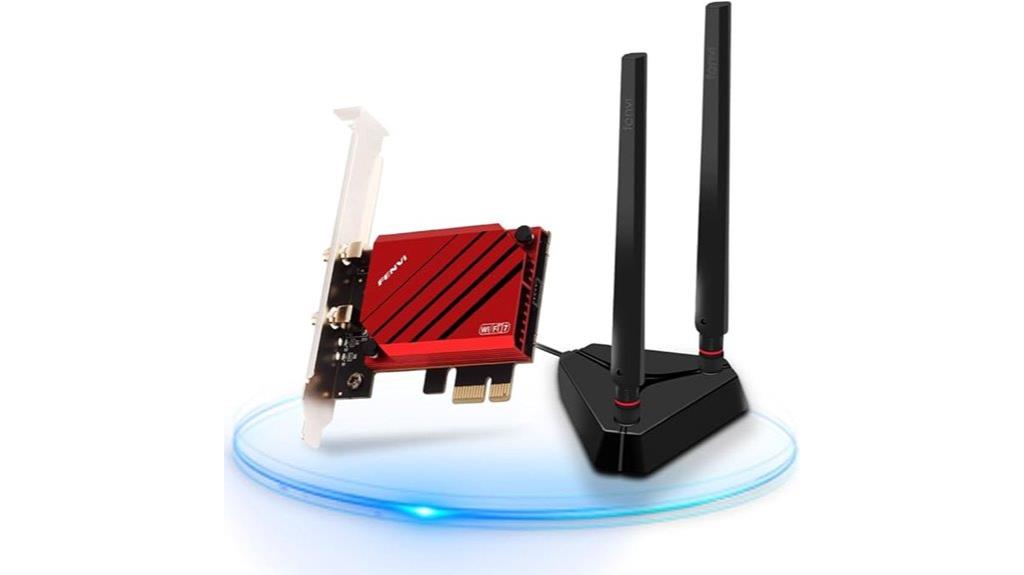
Designed for power users seeking cutting-edge wireless performance, the FENVi PCIe WiFi 7 Network Card (BE8800pro) stands out with its tri-band support and lightning-fast data speeds. It supports 2.4GHz, 5GHz, and 6GHz bands, with the 6GHz reaching nearly 5.8 Gbps—over twice as fast as WiFi 6/6E. Compatible with Windows 11/10 but not AMD motherboards, it offers a maximum bandwidth of 320MHz, boosting responsiveness and reliability for gaming, streaming, and cloud tasks. With Bluetooth 5.4 support and a compact 9-ounce design, this card is a future-proof upgrade for demanding users seeking high-speed, low-latency connectivity.
Best For: power users and gamers seeking the latest high-speed WiFi 7 connectivity with low latency and reliable performance on Windows 11/10 systems.
Pros:
- Supports tri-band WiFi 7 with speeds up to 5.8 Gbps on 6GHz band for ultra-fast data transfer
- Compatible with Windows 11/10, providing future-proof upgrades for demanding applications
- Bluetooth 5.4 support enhances wireless audio, video, and data transfer capabilities
Cons:
- Not compatible with AMD motherboards, limiting some user options
- Requires PCIe slot installation, which may not suit small form factor or older PCs
- Slightly higher price point due to advanced WiFi technology
TP-Link WiFi 6 AX3000 PCIe WiFi Card (Archer TX3000E)

The TP-Link WiFi 6 AX3000 PCIe WiFi Card (Archer TX3000E) stands out as an excellent choice for gamers and streamers seeking ultra-fast, reliable wireless connectivity. Powered by Intel, it leverages Wi-Fi 6 (802.11AX) technology to deliver speeds up to 2.4 Gbps, with OFDMA and MU-MIMO ensuring low latency and smooth performance even in busy networks. Its two multi-directional antennas, mounted on a magnetized base, optimize signal coverage across your desktop. Plus, Bluetooth 5.3 support enables quick pairing with peripherals like controllers and headphones. Easy to install on Windows 10 or 11, it’s a solid upgrade for high-performance wireless setups.
Best For: gamers, streamers, and high-performance PC users seeking ultra-fast, reliable Wi-Fi 6 connectivity with seamless device pairing.
Pros:
- Delivers fast speeds up to 2.4 Gbps, ideal for gaming, streaming, and VR.
- Equipped with two multi-directional antennas for broad and optimized coverage.
- Supports Bluetooth 5.3 for quick, reliable connection with peripherals.
Cons:
- Requires Bluetooth USB cable connected to F_USB connector for Bluetooth functionality.
- Installation may be more complex for users unfamiliar with PCIe cards.
- Driver updates and support depend on TP-Link’s website, which may require manual downloads.
GLOTRENDS WiFi 7 PCIe Card for Desktop PC

If you’re seeking a high-speed Wi-Fi 7 upgrade for your desktop, the GLOTRENDS WiFi 7 PCIe Card stands out with its impressive support for ultra-fast 5.8 Gbps speeds, making it ideal for gamers, streamers, and power users who need reliable, high-bandwidth connections. Powered by the Intel BE200NGW chipset, it supports Wi-Fi 7 and Bluetooth 5.4, offering backward compatibility with earlier Wi-Fi standards. Installation is straightforward on compatible motherboards, though drivers can be tricky on Windows 10. Signal quality depends heavily on antenna placement, and interference from nearby components can affect performance. Overall, it’s a future-proof choice with some setup challenges.
Best For: gamers, streamers, and power users seeking ultrafast Wi-Fi 7 connectivity for high-bandwidth activities on compatible desktop PCs.
Pros:
- Supports ultra-fast 5.8 Gbps speeds with Wi-Fi 7 technology, ideal for demanding applications.
- Compatible with Bluetooth 5.4 and backward Wi-Fi standards, providing versatile connectivity.
- Easy to install on compatible motherboards with high build quality and future-proof design.
Cons:
- Driver installation can be complicated on Windows 10, requiring manual downloads and updates.
- Signal quality heavily depends on antenna placement, with interference from internal components potentially reducing performance.
- Compatibility issues with AMD motherboards and some Windows versions may require driver updates or additional troubleshooting.
Factors to Consider When Choosing Wi‑Fi 7 PCIE Cards

When selecting a Wi‑Fi 7 PCIe card, I focus on compatibility with my hardware and the supported operating systems to guarantee smooth operation. I also consider antenna design and signal range to get reliable coverage, along with speed and latency performance for ideal connectivity. Finally, I look at how easy it is to install and set up the card to save time and avoid frustration.
Compatibility With Hardware
Choosing the right Wi-Fi 7 PCIe card starts with guaranteeing it’s compatible with your hardware. First, check that your motherboard has the correct PCIe slot type—x1, x4, x8, or x16—to fit the card properly. Next, confirm the card supports your operating system; most require Windows 11 and may not work with Windows 10 or Linux. It’s also important to verify compatibility with your motherboard’s chipset, especially if you’re using an AMD system, as some cards aren’t compatible. Additionally, guarantee your system has the necessary internal headers, like USB headers, especially if the card has Bluetooth or external antenna features. Finally, consider the antenna connections and whether they fit your case size and hardware layout for ideal signal reception.
Supported Operating Systems
Since most Wi-Fi 7 PCIe cards are designed primarily for Windows 11, ensuring compatibility with your operating system is essential before making a purchase. These cards typically support Windows 11 64-bit, often requiring specific drivers from manufacturers or chipset providers. Compatibility with Windows 10 or earlier versions is limited; some cards may support Windows 10 through driver updates or generic drivers, but full feature support isn’t guaranteed. Support for Linux and other non-Windows OS options is generally limited and may need manual driver installation or additional configuration. Always check the manufacturer’s specifications to confirm OS compatibility before buying or installing. This step helps avoid driver issues or functionality limitations, ensuring your Wi-Fi 7 card works smoothly with your system.
Antenna and Signal Range
Optimizing your Wi-Fi 7 PCIe card’s signal coverage depends heavily on the antenna design and placement. The number and design of antennas, like external multi-directional ones, directly influence coverage and strength. Antennas with higher gain, measured in dBi, can extend your Wi-Fi range and provide more stable connections across larger areas. Adjustable antennas are a big plus, as they let you fine-tune placement to reduce interference and enhance signal reception. External antennas usually outperform internal ones because they offer better spatial orientation and signal focus. Proper antenna placement is key—keeping them away from obstructions and electronic interference helps maximize range and overall network performance. Paying attention to these factors ensures you get the most reliable and extensive coverage from your Wi-Fi 7 PCIe card.
Speed and Latency Performance
The speed and latency performance of Wi-Fi 7 PCIe cards play a vital role in guaranteeing smooth, responsive connections, especially for demanding tasks like gaming, streaming, and large file transfers. These cards support ultra-high speeds up to 9.3 Gbps, drastically reducing data transfer times. Advanced modulation schemes like 4K-QAM boost throughput and cut latency, making networks more responsive. Features such as Multi-Link Operation (MLO) enable simultaneous multi-band connections, minimizing lag. OFDMA and MU-MIMO technologies allow multiple devices to communicate efficiently, reducing network congestion and improving overall responsiveness. However, to attain peak performance, hardware compatibility, proper antenna placement, and high-quality routers supporting Wi-Fi 7 are indispensable. These factors guarantee you get the fastest, most reliable connection possible.
Installation and Setup Ease
Selecting the right Wi‑Fi 7 PCIe card is crucial for a hassle-free setup, so I always check that it’s compatible with my motherboard’s PCIe slot—whether it’s x1, x4, x8, or x16—to guarantee an easy installation. I also verify that my operating system (Windows 11) supports Wi-Fi 7 drivers to prevent compatibility issues. I look for cards with clear, step-by-step instructions and direct driver download links to streamline setup. Additionally, I confirm the card doesn’t require extra connections, like USB headers for Bluetooth or external antennas, unless my motherboard has those headers available. Finally, I prefer plug-and-play cards or those with automatic driver recognition, which greatly reduce manual configuration and setup time, making the entire process smooth and efficient.
Frequently Asked Questions
How Compatible Are Wi-Fi 7 PCIE Cards With Existing Routers?
Wi-Fi 7 PCIe cards are generally compatible with existing routers, provided your router supports Wi-Fi 7 or at least Wi-Fi 6/6E for backward compatibility. I’ve found that most new cards are designed to work seamlessly with older Wi-Fi standards, so you won’t need a new router right away. Just double-check your router’s specs to guarantee smooth connectivity, and you’ll be good to go.
Do Wi-Fi 7 PCIE Cards Support Mesh Network Integration?
Yes, Wi-Fi 7 PCIe cards support mesh network integration. I’ve found that most modern cards are designed to work seamlessly with mesh systems, allowing me to expand my network effortlessly. This means I can enjoy a more reliable, faster connection across my entire home or office. Just make sure your mesh system is compatible with Wi-Fi 7 to maximize performance, and you’ll experience smoother connectivity everywhere.
What Is the Typical Lifespan of a Wi-Fi 7 PCIE Card?
Think of a Wi-Fi 7 PCIe card like a trusty steed—its lifespan depends on how well you take care of it. Typically, you can expect it to last around 5 to 7 years with proper use and updates. As technology evolves, it might start feeling a bit sluggish, but with good maintenance, it’ll serve you reliably through many online adventures.
Are There Specific Security Features Exclusive to Wi-Fi 7 Cards?
Wi-Fi 7 PCIe cards include some advanced security features, but nothing entirely exclusive to them. They support WPA3 encryption, which offers stronger protection against hacking, and may incorporate improved hardware-based security measures like better encryption algorithms. I recommend checking the specific card’s specs, as some manufacturers add proprietary security tools. Overall, Wi-Fi 7 enhances security, but it still relies on standard protocols like WPA3 for your safety.
Can Wi-Fi 7 PCIE Cards Upgrade Older Wi-Fi Standards?
Yes, Wi-Fi 7 PCIe cards can upgrade your older Wi-Fi standards. They’re backward compatible, so I can connect to previous Wi-Fi networks without issues. This means I get the benefits of faster speeds and better reliability when available, but I can still use my existing routers and networks. Upgrading is straightforward, and it future-proofs my setup as more Wi-Fi 7 networks roll out.
Conclusion
In summary, choosing the right Wi-Fi 7 PCIe card can feel like stepping into a sci-fi movie, but with these top options, you’re well on your way to faster, more reliable connectivity in 2025. Whether you prioritize speed, Bluetooth features, or compatibility, there’s a card here for you. Don’t forget to take into account your specific needs—after all, even in the age of flying cars, a good internet connection remains king.
